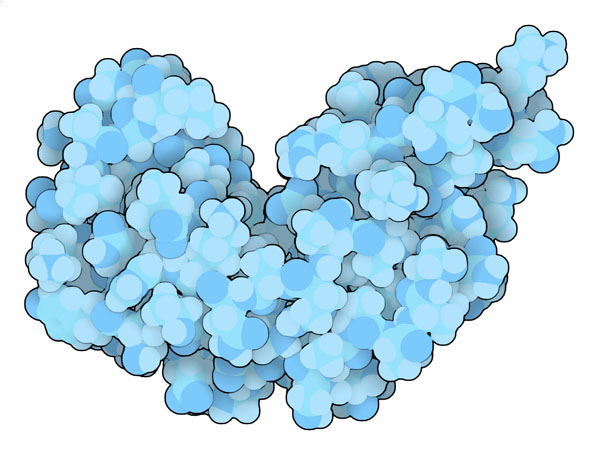|
Inhaltsübersicht | Nanomaschinen | Moleküle | Programme | Kurse | Fun | Links |
||
| > |
Ribonuclease A

Ribonuclease A is the enzyme that digests RNA in our food. Because is it small, stable, and easily purified, ribonuclease has been an important enzyme in biochemical research. It was used by Christian Anfinsen to prove that the sequence of amino acids determines the structure of a folded protein and it was used by Stanford Moore and William Stein to show that a specific arrangement of amino acids is used in the catalytic center of enzymes. Ribonuclease A was also the first enzyme synthesized by R. Bruce Merrifield, showing that biological molecules are simply chemical entities that may be constructed artificially. All of these central concepts, discovered with the help of ribonuclease, were awarded Nobel Prizes.
Fast and Furious
Ribonuclease A, shown here from PDB entry 5rsa, is an endonuclease, which means that it can cut RNA in the middle of a strand. Other ribonucleases degrade RNA from the ends, such as the exosome that is involved in degradation of RNA inside cells. In ribonuclease A, the RNA chain fits in a groove and is attacked by a collection of acidic and basic amino acids. It is a voracious molecular shredder, cleaving after cytidine bases best, and after uridine bases about half as fast. It has been honed by evolution and is one of a select group of diffusion-limited enzymes that act as fast as substrates can get to them.
Steady as a Rock
Ribonuclease A is amazingly stable. For instance, in one procedure for purifying ribonuclease A from cow pancreas, extracts are treated with sulfuric acid and then heated almost to boiling, and ribonuclease A is the only thing that survives. This is not surprising, since it is secreted by the pancreas and needs to perform its job in the inhospitable environment of the digestive tract. The stability of ribonuclease A is due in large part to four disulfide linkages that glue different parts of the chain together.
To look more closely at the active site of ribonuclease A, take a look at the page at Proteopedia.
Next: Precision Cutting
Last changed by: A.Honegger,